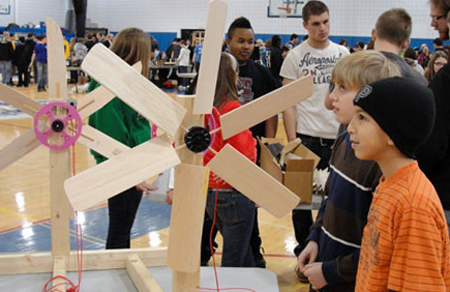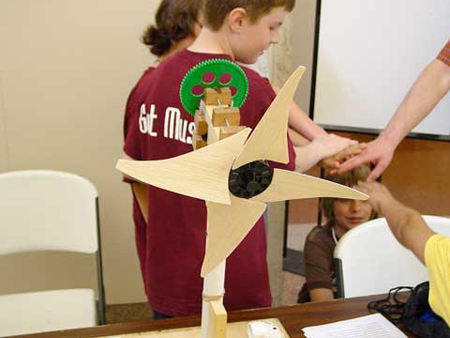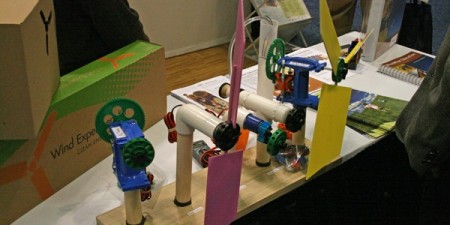Every once in a while we come across a unique and innovative organization trying to make the world a better place through green technology. Such is the case of the KidWind Project located in St. Paul, Minnesota. The company is a team of teachers, engineers, and scientists committed to energy education for the next generation. Over the past 5 years the KidWind Project has trained more than 4500 teachers in 37 states about integrating wind energy science and technology into classrooms.
To learn more about them, we recently interviewed project director Michael Arquin:

EarthTechling (ET): What is the backstory of KidWind? Why was it started?
Michael Arquin: I started KidWind in 2003 when I was a sixth grade science teacher in California. I had been doing quite a bit of work with my students on solar energy doing the Jr. Solar Sprint and other similar activities and wanted one year to start teaching about wind. I was kind of a renewable energy geek! I started to purchase some the wind energy materials that were available from other vendors and was really unhappy with the high price and poor quality of products available. I started tinkering around with some new ways to get students engaged with wind energy, and from there we were off and running.
Things really took off after I received a teacher fellowship at the Wright Center for Science Education at Tufts University. During this fellowship I was able to develop my ideas more fully, do some writing and get the materials out on the web to share with as many teachers as possible. In the summer of 2004 we held our first workshops for teachers in Maine.
The KidWind website was launched in the same year offering free lesson plans and wind energy kits online. The first kit sold for $25 and was shipped from the headquarters of my basement in Arlington, MA. Now we have a small company with 16 employees whose primary focus is the production, development of dissemination of high quality educational materials related to wind energy.
While other companies try to compete with our products, we find our model of open source curriculum development is really hard to beat. All of our print materials, lesson and construction plans are freely downloadable from our website. We sell parts and kits so you can spend only what you need to and you can call KidWind anytime for support. Many times the person who answers the phone and deals with your questions is me.
ET: What do you try to teach about clean energy?
Arquin: What I am trying to do first is help teachers understand where they get their electricity from, what it costs and the impact their energy choices are having globally and locally. Then I try to situate wind – and other renewables – into that framework. I am trying to move people towards a better understanding of the promise of renewable energy but also the limits of the technology. No one is well served by misconceptions that wind power will solve all of our ills. Wind will not solve all of our problems, but it can have an impact and that impact will increase over time if we reduce our consumption and become more efficient.
ET: How does a typical class go using KidWind Products?
Arquin: I like to start a teacher workshop or a class with a MacGyver-like activity where the students have to build a windmill that can lifts some weights with a limited number of materials. With this activity I can show them the complexity and simplicity of wind devices using very inexpensive materials. This mimics the windmills of the past and also allows you to teach some of the theory without teaching about electricity (voltage and amperage etc.).

Once they have explored these ideas, you can move to the Basic Turbine and explore how blades affect electricity production. Using these simple turbines you can explore experimental design, energy transformations and even series and parallel circuits by building small wind farms.
As you get more advanced, we have devices like the AL Turbine which add the ability to change gearing and generator types. You can start to build generators from the ground up and see how magnets and wire size can affect a generators’ ability to produce electricity. You can also start combining our wind turbines with fuel cells, solar panels and water pumps to build hybrid generation systems. You can also initiate projects where students explore installing a wind turbine at their school. To do this, students need to collect and analyze wind data, understand how much electricity their school uses, and see what kind of turbine might work well in their area.
With our new WindWise curriculum we have lots of other lessons on wildlife impacts, wind farm financing and the impacts of wind power on climate change.
ET: Talk about the KidWind Challenge. What goes into one?
Arquin: The KidWind Challenge is a student-oriented wind turbine design contest. It is basically taking what we do in the classroom and then having a couple of hundred students meet up somewhere and do it together with bigger more complicated wind turbines. During the challenge, students spend time designing and constructing their own wind turbines with the goal of creating something that is both efficient and elegant. Student teams eventually convene, and the performance of their turbines is evaluated in our portable wind tunnels. The wind tunnels are basically a bunch of fans ganged together to build a 48” x 48” square space that blows the wind 5-8m/s.
I got the idea for this challenge while I was a middle school science teacher. While holding a Junior Solar Sprint Competition in my classroom, I decided to try the same concept using wind energy. Though fellow teachers have likely put on such events in their own classrooms, the KidWind Challenge is the first to try and implement a standardized, nationwide set of guidelines.
The excitement students exhibited during this classroom project proved that creating such a competition was a worthwhile endeavor. For years afterwards, during which time he founded the KidWind Project, I had wanted to put on a large-scale event with more students and teams. I finally got my chance in 2008 when the first official KidWind Challenge was put on in New York through a grant from the New York State Energy Research and Development Authority (NYSERDA). Funds from this grant were used to build a portable wind tunnel and move the Challenge between four locations during the school year.
The KidWind Challenge is now in its third year in New York. By now, we’ve gotten better at building wind tunnels, and students have gotten even better at buildings turbines! In 2010 we the KidWind Challenge to Dallas, Texas for WindPower 2010, the largest wind energy show in the world. Close to 200 students participated, and even though it’s a lot of work to take our show on the road, replicating the Challenge’s model in a new location was a great experience. We hope to offer Challenges in MN, NY, CA, CO and IA. From there, the sky is the limit!
ET: What is next for the KidWind Project?
Arquin: Basically we are working to expand our training network to impact more teachers and students in more states and communities.
In the summer of 2011, we also hope to run the 3rd series of the WindSenators program in Fort Collins, CO. This training program seeks to expand our core of WindMaster teacher trainers to a total of 70 master trainers and add more states to our network. This week long workshop will work with teachers to improve their understanding of wind energy science and engineering along with exposing them to a wide variety of curricular vehicles that can engage students in the classroom.
We are also working to launch a retail line of renewable energy kits. So hopefully in 8-12 months you will see some Kidwind products not just on our website but in other shops and stores in your community. This is on top of expanding some of our training programs to South America and Europe with some motivated partners in these regions and are working to translate our core materials into Spanish, German and French.

ET: How many students and teachers have taken part in the KidWind project this year? How many school districts participated in the program?
Arquin: This is somewhat hard to pin down as thousands of people use our website as we have lots of free lessons, PowerPoints and building plans available. Over the last 6 years we have probably worked with at least 6500 teachers in a variety of training formats who are going to bring this content back to the classroom. These teachers are in 39 states and hundreds of school districts.
If each of those teachers works with 50-100 students each year, then I guess we’re talking about 300-500K students each year that may be impacted. We also work with thousands of students doing science fair projects and other related projects. These are rough numbers but they are increasing every year, as people are interested in learning how wind energy works.